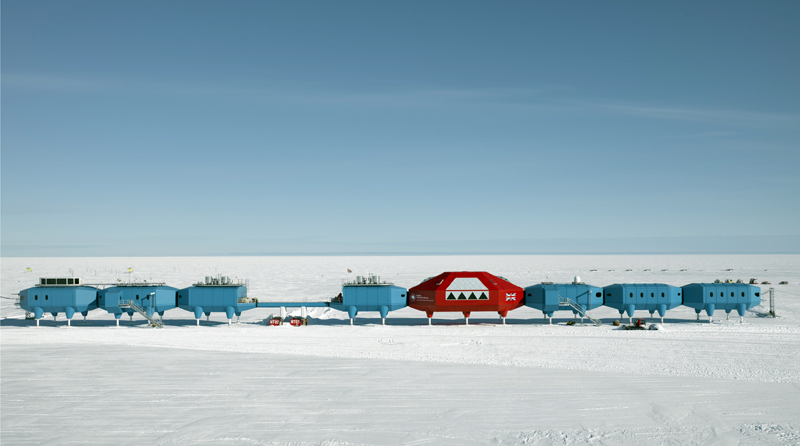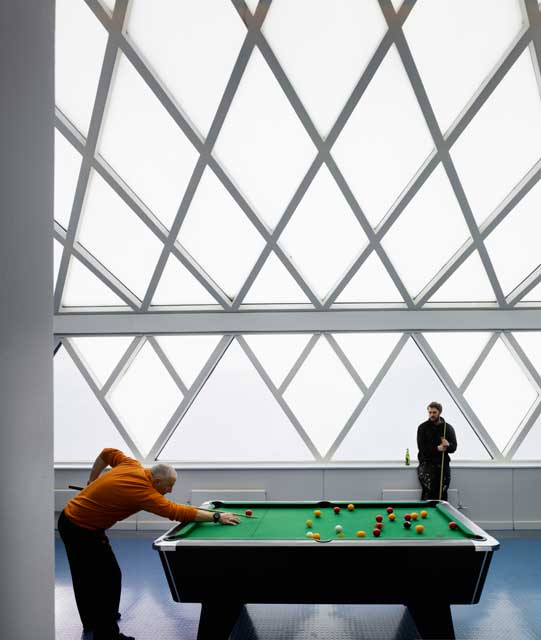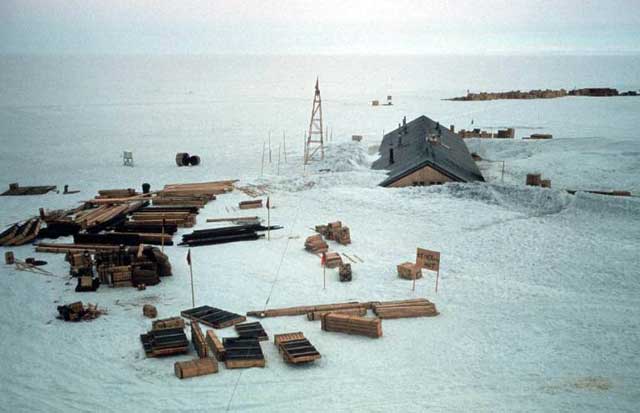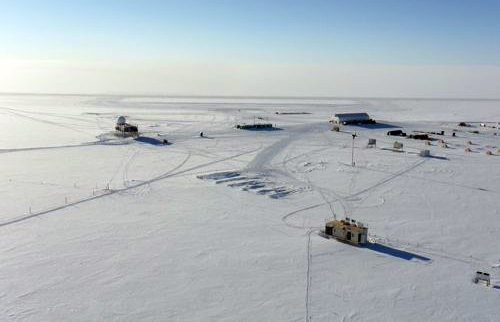|
Location, location ... relocationBritain's Halley Station offers new design concepts for polar constructionPosted December 6, 2013
Halley VI Research Station But this metal monster can come to life. Halley VI is the Antarctic’s first fully relocatable research station, with each of its modules outfitted with hydraulically controlled legs that sit on giant skis. The design of the space-age-looking Antarctic base is the brainchild of Hugh Broughton Architects “At Halley, we needed a new design that would not only jack it up above the rising snow level, but also could be relocated – a wholly new challenge for these research facilities,” Broughton explained. The first Halley station was built by the U.K. in 1956 for the International Geophysical Year (IGY) “Everything that you leave on the snow surface will get buried,” Broughton noted. The succeeding iterations of Halley Station also lost the battle with the elements, becoming buried or crushed by snowfall that averaged four to five feet per year. Halley III, for instance, suffered a particularly dramatic fate when it was later spotted in the 1980s at the face of the ice shelf, poised to be spewed into the Weddell Sea. Halley V avoided that particular end. It had been completed in 1992 with a different concept. It was built above the surface on steel legs with an electric screw jack system to lift the building above the rising snow level. But the lift system itself was complicated, employing eight people for nine weeks – and involving the entire station population for at least a couple of days every summer season. Snow buried the foundation each year, requiring workers to cut the legs, realign them and weld on new steel to extend them. “It was a very labor intensive process,” Broughton said. In the end, however, Halley V wasn’t defeated by snow, but by location. One year it found itself on the wrong side of an emerging crack that will eventually send a large chunk of the Brunt Ice Shelf out to sea. The ice shelf, a floating slab of ice fed by glaciers, moves about 2,000 feet per year. Inevitably, every structure stuck in the ice is headed out to sea. The design of the Halley VI modules, mounted on hydraulic legs with huge skis, is the latest attempt to trump one of the toughest environments on Earth. In addition, the shape of the modules allows the wind to scour the snow from underneath, keeping the skis clear. It only takes four people about a week to lift the entire line of modules above the snow surface each year. Each module is about 1,600 square feet, with two dedicated for dormitories, another two for power and water generation, along with a command center and laboratory. A much larger, 5,000-square-foot module is the social hub of the station, containing the kitchen, cafeteria and recreational spaces. After four years of construction, Halley IV was completed in 2012 and officially dedicated earlier this year. “Learning from the failures of Halley V, we were very keen that all those spaces should be combined in one big module that could be the social heart of the station,” said Broughton, adding that a color psychologist was employed to suggest nuances that would “help with the winter blues.” “At every turn we looked at how we could help people, particularly suffering sensory deprivation in a place like Halley,” he said. One feature that didn’t make it into the final design was a hydroponic greenhouse. The new Amundsen-Scott South Pole Station “Everyone is aware of the South Pole installation. I keep arguing: Look how successful that is. Let’s get it into Halley. I’m sure at some stage it will be installed,” Broughton said. The two stations, separated by about 900 miles of ice, also share similar science missions, as both facilities support upper atmospheric and astrophysical research. In fact, a U.S.-led project called BARREL (Balloon Array for RBSP Relativistic Electron Losses) Broughton’s design for Halley VI has won more than just accolades – the latest being the British Construction Industry International Award – as the U.K. architectural firm has been awarded additional work in the Antarctic, including the design of a Spanish research station, Juan Carlos on Livingston Island. The latest venture with partner AECOM involves the design of a new research laboratory in Greenland at NSF’s Summit Station for atmospheric research. “There are a lot of similarities to the Halley modules, but it’s developed specifically for the NSF program. There are also refinements. It’s like developing a car and then improving the model each time when you work on it,” Broughton said. For example, the new Atmospheric Watch Observatory (AWO) will be clad in the same highly insulated, pre-glazed fiber reinforced plastic (FRP) panels as Halley VI. However, due to the sensitivity of the instruments, there can be no off-gassing from the construction materials. Construction logistics of the AWO is still being worked out, according to Patrick Haggerty, program manager for NSF Arctic Research Support & Logistics “After that, funding will become our constraint,” Haggerty said via e-mail. In addition to the AWO, there are plans to install a large radio telescope at Summit Station as part of a collaboration between the Smithsonian Astrophysical Observatory and ASIA-A “Structures will be needed to support their project,” Haggerty said. “We hope to upgrade our facilities in the Summit area over the next few years.” Will another giant metal centipede or some other futuristic-looking station rise on the Greenland ice plateau? Only time will tell. |



For USAP Participants |
For The Public |
For Researchers and EducatorsContact UsNational Science FoundationOffice of Polar Programs Geosciences Directorate 2415 Eisenhower Avenue, Suite W7100 Alexandria, VA 22314 Sign up for the NSF Office of Polar Programs newsletter and events. Feedback Form |








